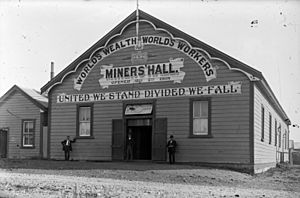Runanga Miners' Hall facts for kids
Quick facts for kids Runanga Miners' Hall |
|
|---|---|

Runanga Miners' Hall in 2009
|
|
| General information | |
| Type | Community hall |
| Architectural style | Frontier style |
| Address | 7 McGowan Street |
| Town or city | Runanga |
| Country | New Zealand |
| Coordinates | 42°24′1.7″S 171°15′3.8″E / 42.400472°S 171.251056°E |
| Opened | 20 August 1937 |
| Technical details | |
| Material | Timber, glass, corrugated steel |
| Design and construction | |
| Architect | George Millar |
| Main contractor | Jack McMillan |
| Designated: | 2 May 2013 |
| Reference #: | 9613 |
The Runanga Miners' Hall is a special building in the town of Runanga. This town is on the West Coast of New Zealand's South Island. The hall you see today was built in 1937. It replaced an older miners' hall from 1908 that was unfortunately destroyed by fire. This hall is important because of its role in the history of workers' rights in New Zealand. In 2013, Heritage New Zealand recognized it as a historic place, giving it a special Category 1 status.
Contents
What is the History of the Runanga Miners' Hall?
At the start of the 1900s, groups of workers called unions were becoming very strong. The coal mine in Runanga was a key place for these unions. It was also important for people called socialists. Socialists believed that important industries, like coal mining, should be owned by the country, not by private companies.
How Was the First Miners' Hall Built?
Plans for the first hall began in 1905. A famous union leader and politician named Bob Semple helped a lot to plan and build it. The hall was built at the corner of Mills and McGowan Streets. It officially opened on December 4, 1908, with Bob Semple doing the honors. A special train even brought people from Greymouth to Runanga for the big event!
This first hall was very unique. It was the first building in New Zealand built by a group effort. The State Miners' Union, the mines themselves, local businesses from Greymouth, and the government all worked together. George Millar, an engineer from the mines, designed the building. Walter Murray from Cobden was the builder.
What Happened to the Original Hall?
In January 1937, a fire completely destroyed the first hall. The union office next to it was also burned down. People thought the fire might have been started on purpose because of political reasons. However, no one was ever found responsible.
Just nine months later, a new hall was built in its place. George Millar designed this new building too. J. McMillan from Cobden was the builder this time.
How Was the Hall Used Over Time?
In 1940, a special memorial service was held in the hall. It was for Michael Joseph Savage, who was New Zealand's first Labour prime minister.
The State Miners' Union stopped owning the building in the 1960s. After that, the hall was used as a factory that made wooden goods. In 1980, it became the Runanga District Community Centre. The building was repaired and updated in 1983 and again in 2000.
In 2012, the hall had to close because of worries about earthquakes. A big project to make the building stronger and fix it up started in 2020.
Throughout its history, the hall was a busy place for the community. It hosted many social events. These included union and political meetings, concerts, shows, and dances. It was also used as a movie theater and a town hall.
What Does the Runanga Miners' Hall Look Like?
The first hall, built in 1908, had a pointed roof. It had a main door in the middle with two windows on either side. The hall built in 1937 looks different. It has round-topped windows and a stepped roofline. It also has a curved top part.
Its style is called "frontier style." It also has some features from Neo-Georgian and Italianate designs. These styles were not very common for buildings in the 1930s.
What Slogans Are on the Hall?
Several important sayings were painted on the hall, both inside and outside. Inside, you could read things like "World's wealth for the world's workers." Another one was "Not for a race, but for all mankind." And also, "The world is our country, to do good is our religion."
On the outside, the slogan "United we stand, divided we fall" was painted in 1908. A sign painter named James Begg Kent did this work. Kent later became a Member of Parliament for the Labour Party. This same slogan was repainted on the new building in 1937. However, it was covered up when the building was used as a factory. Luckily, it was uncovered again during the renovations in 2000.
What is the Current Status of the Hall?
Since 2013, the Runanga Miners' Hall has been officially recognized. Heritage New Zealand registered it as a Category I structure. Its registration number is 9613. This high status shows how important the hall is. It played a big part in the history of organized labor and the Labour Party in New Zealand. It is also one of the very few miners' halls that still exist today.


